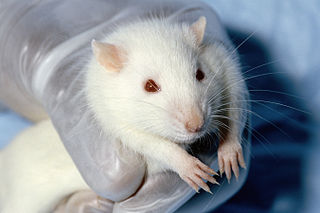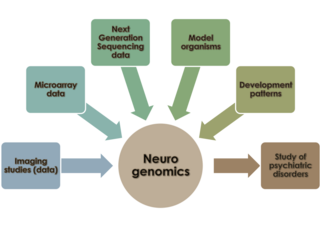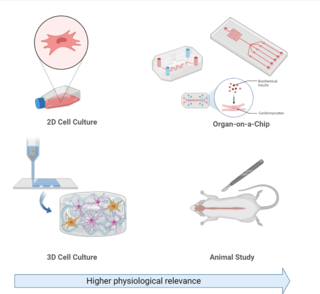Related Research Articles

The zebrafish is a freshwater fish belonging to the minnow family (Cyprinidae) of the order Cypriniformes. Native to India and South Asia, it is a popular aquarium fish, frequently sold under the trade name zebra danio. It is also found in private ponds.

A model organism is a non-human species that is extensively studied to understand particular biological phenomena, with the expectation that discoveries made in the model organism will provide insight into the workings of other organisms. Model organisms are widely used to research human disease when human experimentation would be unfeasible or unethical. This strategy is made possible by the common descent of all living organisms, and the conservation of metabolic and developmental pathways and genetic material over the course of evolution.

In genetics, the phenotype is the set of observable characteristics or traits of an organism. The term covers the organism's morphology, its developmental processes, its biochemical and physiological properties, its behavior, and the products of behavior. An organism's phenotype results from two basic factors: the expression of an organism's genetic code and the influence of environmental factors. Both factors may interact, further affecting the phenotype. When two or more clearly different phenotypes exist in the same population of a species, the species is called polymorphic. A well-documented example of polymorphism is Labrador Retriever coloring; while the coat color depends on many genes, it is clearly seen in the environment as yellow, black, and brown. Richard Dawkins in 1978 and then again in his 1982 book The Extended Phenotype suggested that one can regard bird nests and other built structures such as caddisfly larva cases and beaver dams as "extended phenotypes".
Gene knockouts are a widely used genetic engineering technique that involves the targeted removal or inactivation of a specific gene within an organism's genome. This can be done through a variety of methods, including homologous recombination, CRISPR-Cas9, and TALENs.

Animal testing, also known as animal experimentation, animal research, and in vivo testing, is the use of non-human animals in experiments that seek to control the variables that affect the behavior or biological system under study. This approach can be contrasted with field studies in which animals are observed in their natural environments or habitats. Experimental research with animals is usually conducted in universities, medical schools, pharmaceutical companies, defense establishments, and commercial facilities that provide animal-testing services to the industry. The focus of animal testing varies on a continuum from pure research, focusing on developing fundamental knowledge of an organism, to applied research, which may focus on answering some questions of great practical importance, such as finding a cure for a disease. Examples of applied research include testing disease treatments, breeding, defense research, and toxicology, including cosmetics testing. In education, animal testing is sometimes a component of biology or psychology courses. The practice is regulated to varying degrees in different countries.

The house mouse is a small mammal of the order Rodentia, characteristically having a pointed snout, large rounded ears, and a long and almost hairless tail. It is one of the most abundant species of the genus Mus. Although a wild animal, the house mouse has benefited significantly from associating with human habitation to the point that truly wild populations are significantly less common than the semi-tame populations near human activity.

The laboratory mouse or lab mouse is a small mammal of the order Rodentia which is bred and used for scientific research or feeders for certain pets. Laboratory mice are usually of the species Mus musculus. They are the most commonly used mammalian research model and are used for research in genetics, physiology, psychology, medicine and other scientific disciplines. Mice belong to the Euarchontoglires clade, which includes humans. This close relationship, the associated high homology with humans, their ease of maintenance and handling, and their high reproduction rate, make mice particularly suitable models for human-oriented research. The laboratory mouse genome has been sequenced and many mouse genes have human homologues. Lab mice sold at pet stores for snake food can also be kept as pets.

Plasmodium berghei is a single-celled parasite causing rodent malaria. It is in the Plasmodium subgenus Vinckeia.
A transgene is a gene that has been transferred naturally, or by any of a number of genetic engineering techniques, from one organism to another. The introduction of a transgene, in a process known as transgenesis, has the potential to change the phenotype of an organism. Transgene describes a segment of DNA containing a gene sequence that has been isolated from one organism and is introduced into a different organism. This non-native segment of DNA may either retain the ability to produce RNA or protein in the transgenic organism or alter the normal function of the transgenic organism's genetic code. In general, the DNA is incorporated into the organism's germ line. For example, in higher vertebrates this can be accomplished by injecting the foreign DNA into the nucleus of a fertilized ovum. This technique is routinely used to introduce human disease genes or other genes of interest into strains of laboratory mice to study the function or pathology involved with that particular gene.

Rodents are commonly used in animal testing, particularly mice and rats, but also guinea pigs, hamsters, gerbils and others. Mice are the most commonly used vertebrate species, due to their availability, size, low cost, ease of handling, and fast reproduction rate.
A humanized mouse is a mouse carrying functioning human genes, cells, tissues, and/or organs. Humanized mice are commonly used as small animal models in biological and medical research for human therapeutics.

A genetically modified mouse or genetically engineered mouse model (GEMM) is a mouse that has had its genome altered through the use of genetic engineering techniques. Genetically modified mice are commonly used for research or as animal models of human diseases and are also used for research on genes. Together with patient-derived xenografts (PDXs), GEMMs are the most common in vivo models in cancer research. Both approaches are considered complementary and may be used to recapitulate different aspects of disease. GEMMs are also of great interest for drug development, as they facilitate target validation and the study of response, resistance, toxicity and pharmacodynamics.
The diet-induced obesity model is an animal model used to study obesity using animals that have obesity caused by being fed high-fat or high-density diets. It is intended to mimic the most common cause of obesity in humans. Typically mice, rats, dogs, or non-human primates are used in these models. These animals can then be used to study in vivo obesity, obesity's comorbidities, and other related diseases. Users of such models must take into account the duration and type of diet as well as the environmental conditions and age of the animals, as each may promote different bodyweights, fat percentages, or behaviors.

Genetically modified animals are animals that have been genetically modified for a variety of purposes including producing drugs, enhancing yields, increasing resistance to disease, etc. The vast majority of genetically modified animals are at the research stage while the number close to entering the market remains small.

Neurogenomics is the study of how the genome of an organism influences the development and function of its nervous system. This field intends to unite functional genomics and neurobiology in order to understand the nervous system as a whole from a genomic perspective.

The tail flick test is a test of the pain response in animals, similar to the hot plate test. It is used in basic pain research and to measure the effectiveness of analgesics, by observing the reaction to heat. It was first described by D'Amour and Smith in 1941.
Animal models of depression are research tools used to investigate depression and action of antidepressants as a simulation to investigate the symptomatology and pathophysiology of depressive illness or used to screen novel antidepressants.
A knockout mouse, or knock-out mouse, is a genetically modified mouse in which researchers have inactivated, or "knocked out", an existing gene by replacing it or disrupting it with an artificial piece of DNA. They are important animal models for studying the role of genes which have been sequenced but whose functions have not been determined. By causing a specific gene to be inactive in the mouse, and observing any differences from normal behaviour or physiology, researchers can infer its probable function.
Breast cancer metastatic mouse models are experimental approaches in which mice are genetically manipulated to develop a mammary tumor leading to distant focal lesions of mammary epithelium created by metastasis. Mammary cancers in mice can be caused by genetic mutations that have been identified in human cancer. This means models can be generated based upon molecular lesions consistent with the human disease.

Experimental models of Alzheimer's disease are organism or cellular models used in research to investigate biological questions about Alzheimer's disease as well as develop and test novel therapeutic treatments. Alzheimer's disease is a progressive neurodegenerative disorder associated with aging, which occurs both sporadically or due to familial passed mutations in genes associated with Alzheimer's pathology. Common symptoms associated with Alzheimer's disease include: memory loss, confusion, and mood changes.
References
- ↑ Chakraborty C, Hsu CH, Wen ZH, Lin CS, Agoramoorthy G (February 2009). "Zebrafish: a complete animal model for in vivo drug discovery and development". Current Drug Metabolism. 10 (2): 116–24. doi:10.2174/138920009787522197. PMID 19275547.
- 1 2 Kari G, Rodeck U, Dicker AP (July 2007). "Zebrafish: an emerging model system for human disease and drug discovery". Clinical Pharmacology and Therapeutics. 82 (1): 70–80. doi:10.1038/sj.clpt.6100223. PMID 17495877. S2CID 41443542.
- ↑ "Pinel Chapter 6 - Human Brain Damage & Animal Models". Academic.uprm.edu. Archived from the original on 2014-10-13. Retrieved 2014-01-10.
- ↑ Hedges SB (November 2002). "The origin and evolution of model organisms". Nature Reviews. Genetics. 3 (11): 838–49. doi:10.1038/nrg929. PMID 12415314. S2CID 10956647.
- ↑ Bejerano G, Pheasant M, Makunin I, Stephen S, Kent WJ, Mattick JS, Haussler D (May 2004). "Ultraconserved elements in the human genome". Science. 304 (5675): 1321–5. Bibcode:2004Sci...304.1321B. doi:10.1126/science.1098119. PMID 15131266. S2CID 2790337.
- 1 2 Waterston RH, Lindblad-Toh K, Birney E, Rogers J, Abril JF, Agarwal P, et al. (December 2002). "Initial sequencing and comparative analysis of the mouse genome". Nature. 420 (6915): 520–62. Bibcode:2002Natur.420..520W. doi: 10.1038/nature01262 . PMID 12466850.
- ↑ Kehrer-Sawatzki H, Cooper DN (February 2007). "Understanding the recent evolution of the human genome: insights from human-chimpanzee genome comparisons". Human Mutation. 28 (2): 99–130. doi: 10.1002/humu.20420 . PMID 17024666. S2CID 42037159.
- ↑ Kehrer-Sawatzki H, Cooper DN (February 2007). "Structural divergence between the human and chimpanzee genomes". Human Genetics. 120 (6): 759–78. doi:10.1007/s00439-006-0270-6. PMID 17066299. S2CID 6484568.
- ↑ Prüfer K, Munch K, Hellmann I, Akagi K, Miller JR, Walenz B, et al. (June 2012). "The bonobo genome compared with the chimpanzee and human genomes". Nature. 486 (7404): 527–31. Bibcode:2012Natur.486..527P. doi:10.1038/nature11128. PMC 3498939 . PMID 22722832.
- ↑ Hughes HC, Lang CM (December 1978). "Basic principles in selecting animal species for research projects". Clinical Toxicology. 13 (5): 611–21. doi:10.3109/15563657808988266. PMID 750165.
- ↑ White HS (1997). "Clinical significance of animal seizure models and mechanism of action studies of potential antiepileptic drugs". Epilepsia. 38 (Suppl 1): S9-17. doi:10.1111/j.1528-1157.1997.tb04523.x. PMID 9092952.
- ↑ Bolton C (October 2007). "The translation of drug efficacy from in vivo models to human disease with special reference to experimental autoimmune encephalomyelitis and multiple sclerosis". Inflammopharmacology. 15 (5): 183–7. doi:10.1007/s10787-007-1607-z. PMID 17943249. S2CID 8366509.
- ↑ Leker RR, Constantini S (2002). "Experimental Models in Focal Cerebral Ischemia: Are we there yet?". Research and Publishing in Neurosurgery. pp. 55–9. doi:10.1007/978-3-7091-6743-4_10. ISBN 978-3-7091-7399-2. PMID 12442622.
{{cite book}}:|journal=ignored (help) - ↑ Wang J, Fields J, Doré S (July 2008). "The development of an improved preclinical mouse model of intracerebral hemorrhage using double infusion of autologous whole blood". Brain Research. 1222: 214–21. doi:10.1016/j.brainres.2008.05.058. PMC 4725309 . PMID 18586227.
- ↑ Rynkowski MA, Kim GH, Komotar RJ, Otten ML, Ducruet AF, Zacharia BE, et al. (2008). "A mouse model of intracerebral hemorrhage using autologous blood infusion". Nature Protocols. 3 (1): 122–8. doi:10.1038/nprot.2007.513. PMID 18193028. S2CID 22553744.
- ↑ Korneev KV (18 October 2019). "[Mouse Models of Sepsis and Septic Shock]". Molekuliarnaia Biologiia. 53 (5): 799–814. doi: 10.1134/S0026893319050108 . PMID 31661479. S2CID 204758015.
- ↑ Eibl RH, Kleihues P, Jat PS, Wiestler OD (March 1994). "A model for primitive neuroectodermal tumors in transgenic neural transplants harboring the SV40 large T antigen". The American Journal of Pathology. 144 (3): 556–64. PMC 1887088 . PMID 8129041.
- ↑ Radner H, el-Shabrawi Y, Eibl RH, Brüstle O, Kenner L, Kleihues P, Wiestler OD (1993). "Tumor induction by ras and myc oncogenes in fetal and neonatal brain: modulating effects of developmental stage and retroviral dose". Acta Neuropathologica. 86 (5): 456–65. doi:10.1007/bf00228580. PMID 8310796. S2CID 2972931.
- ↑ Homo-Delarche F, Drexhage HA (May 2004). "Immune cells, pancreas development, regeneration and type 1 diabetes". Trends in Immunology. 25 (5): 222–9. doi:10.1016/j.it.2004.02.012. PMID 15099561.
- ↑ Yousefzadeh N, Kashfi K, Jeddi S, Ghasemi A (2020-01-10). "Ovariectomized rat model of osteoporosis: a practical guide". EXCLI Journal. 19: 89–107. doi:10.17179/excli2019-1990. PMC 7003643 . PMID 32038119.
- ↑ Hisaeda H, Maekawa Y, Iwakawa D, Okada H, Himeno K, Kishihara K, et al. (January 2004). "Escape of malaria parasites from host immunity requires CD4+ CD25+ regulatory T cells". Nature Medicine. 10 (1): 29–30. doi:10.1038/nm975. PMID 14702631. S2CID 2111178.
- ↑ Coppi A, Cabinian M, Mirelman D, Sinnis P (May 2006). "Antimalarial activity of allicin, a biologically active compound from garlic cloves". Antimicrobial Agents and Chemotherapy. 50 (5): 1731–7. doi:10.1128/AAC.50.5.1731-1737.2006. PMC 1472199 . PMID 16641443.
- ↑ Frischknecht F, Martin B, Thiery I, Bourgouin C, Menard R (March 2006). "Using green fluorescent malaria parasites to screen for permissive vector mosquitoes". Malaria Journal. 5: 23. doi: 10.1186/1475-2875-5-23 . PMC 1450296 . PMID 16569221.
- ↑ Olson H, Betton G, Robinson D, Thomas K, Monro A, Kolaja G, et al. (August 2000). "Concordance of the toxicity of pharmaceuticals in humans and in animals". Regulatory Toxicology and Pharmacology. 32 (1): 56–67. doi:10.1006/rtph.2000.1399. PMID 11029269. S2CID 17158127.
- ↑ Davidson MK, Lindsey JR, Davis JK (June 1987). "Requirements and selection of an animal model". Israel Journal of Medical Sciences. 23 (6): 551–5. PMID 3312096.
- ↑ Hasler G, Drevets WC, Manji HK, Charney DS (October 2004). "Discovering endophenotypes for major depression". Neuropsychopharmacology. 29 (10): 1765–81. doi: 10.1038/sj.npp.1300506 . PMID 15213704.
- ↑ Martin B, Ji S, Maudsley S, Mattson MP (April 2010). ""Control" laboratory rodents are metabolically morbid: why it matters". Proceedings of the National Academy of Sciences of the United States of America. 107 (14): 6127–33. Bibcode:2010PNAS..107.6127M. doi: 10.1073/pnas.0912955107 . PMC 2852022 . PMID 20194732.
- ↑ "What Investigators Need to Know About the Use of Animals" (PDF). National Institutes of Health. April 2016. Retrieved 2020-04-26.
- ↑ Kendall LV, Owiny JR, Dohm ED, Knapek KJ, Lee ES, Kopanke JH, et al. (December 2018). "Replacement, Refinement, and Reduction in Animal Studies With Biohazardous Agents". ILAR Journal. 59 (2): 177–194. doi: 10.1093/ilar/ily021 . PMID 30668740.
- ↑ "Alternatives to animal testing". Unilever . Retrieved 2021-05-03.
- 1 2 Doke SK, Dhawale SC (July 2015). "Alternatives to animal testing: A review". Saudi Pharmaceutical Journal. 23 (3): 223–9. doi:10.1016/j.jsps.2013.11.002. PMC 4475840 . PMID 26106269.
- ↑ Kim TW, Che JH, Yun JW (July 2019). "Use of stem cells as alternative methods to animal experimentation in predictive toxicology". Regulatory Toxicology and Pharmacology. 105: 15–29. doi:10.1016/j.yrtph.2019.03.016. PMID 30930176. S2CID 89618750.
- ↑ Heindl C, Hess A, Brune K (2008). "Refinement and reduction in animal experimentation: options for new imaging techniques". Altex. 25 (2): 121–5. doi: 10.14573/altex.2008.2.121 . PMID 18551236.